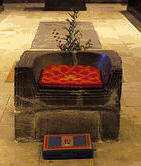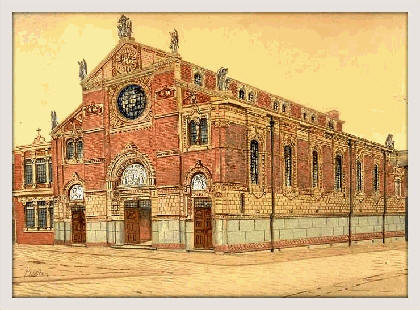I was interested to read the article about St Wilfrid in
the Harvest edition of our church magazine. It brought to mind a holiday I spent
with a friend, a few years ago, in North East England, following in the
footsteps of The Northern Saints, including St Wilfrid.
 We visited
Hexham Abbey to see St Wilfrid’s chair in the main aisle, and the small crypt
where he used to pray. We visited Ripon Cathedral (he was responsible for its
building), York Minster, Durham Cathedral and Lidisfarne on Holy Island – all
having associations with St Wilfrid and other northern saints such as Bede,
Aidan and Cuthbert.
We visited
Hexham Abbey to see St Wilfrid’s chair in the main aisle, and the small crypt
where he used to pray. We visited Ripon Cathedral (he was responsible for its
building), York Minster, Durham Cathedral and Lidisfarne on Holy Island – all
having associations with St Wilfrid and other northern saints such as Bede,
Aidan and Cuthbert.
I have always been interested in learning about St Wilfrid
because we, in Preston, owe him a great deal as he brought Christianity to our
town in Anglo-Saxon times. His name is worthy of note: ‘Wil’ meaning ‘wishful
of’ and ‘Frith’ meaning ‘peace’. He was adopted as the patron saint of Preston,
his emblem becoming Preston’s coat-of-arms: the lamb of peace (altered from a
standing lamb to one sitting down) and ‘P.P.’ at the base standing for ‘Princeps
Pacis’ – Prince of Peace – because his name means ‘peace’.

There could be no better sign representing the Prince of
Peace, Our Lord and Saviour Jesus Christ.
Until the Reformation our parish church was dedicated to
St Wilfrid, but then came a name change to St John’s. However, St Wilfrid’s
became the name of the Roman Catholic church in Chapel Street, which leads off
Fishergate into Winckley Square. It is a beautiful church, with pillars of white
Italian Carrara marble, and is well worth a visit. There is also St Wilfrid’s
Street which runs between Fox Street and Corporation Street.
When St Wilfrid brought Christianity to Preston he was
accompanied by Benedict Biscop. His name is remembered in the area of north
Blackpool, first as Biscopham and which later became Bispham. Biscop was
responsible for introducing stained glass windows into churches to enhance and
improve the work of their builders.
Enid Singleton
 We visited
Hexham Abbey to see St Wilfrid’s chair in the main aisle, and the small crypt
where he used to pray. We visited Ripon Cathedral (he was responsible for its
building), York Minster, Durham Cathedral and Lidisfarne on Holy Island – all
having associations with St Wilfrid and other northern saints such as Bede,
Aidan and Cuthbert.
We visited
Hexham Abbey to see St Wilfrid’s chair in the main aisle, and the small crypt
where he used to pray. We visited Ripon Cathedral (he was responsible for its
building), York Minster, Durham Cathedral and Lidisfarne on Holy Island – all
having associations with St Wilfrid and other northern saints such as Bede,
Aidan and Cuthbert.